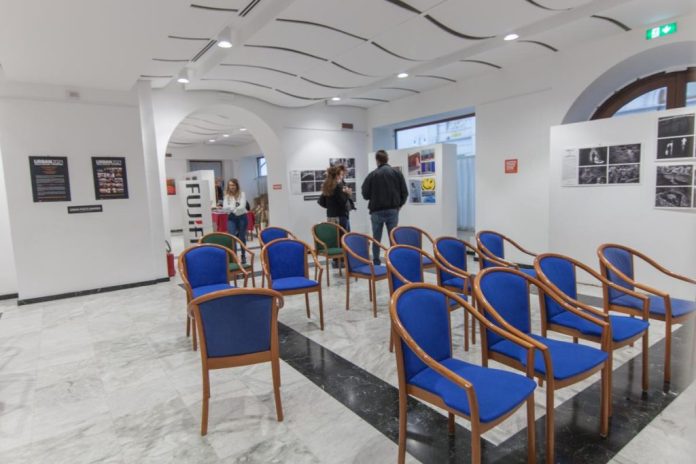by InTrieste
In a mesmerizing display of artistic prowess, Francesco Carbone brings Dante Alighieri’s masterpiece, the Commedia, to life in his exhibition “Innocenze.” Carbone, a versatile artist known for his work as a painter, engraver, and essayist, is set to debut his visual interpretation of the entire Commedia at the Xenia Hall on Thursday, January 18, 2024, at 5:30 PM (local time).
Unlike traditional miniaturists who confined their illustrations to the margins of the text, Carbone’s creations boldly spill across the pages, often taking over the entire canvas. The fusion of words and drawings weaves a seamless tapestry, redefining the reader’s experience. The ancient artistry is further enhanced by Carbone’s digital reworking and printing techniques, marrying the old and the new in a visual exploration of Dante’s narrative.
The thematic core of “Innocenze” revolves around juxtapositions of “text-figures” and variations on the Crucifixion. Dante’s portrayal of Christ’s sacrifice as the key to salvation from the Dark Forest serves as a poignant backdrop. The tragic narrative of violated innocents echoes as a somber counterpoint to the timeless human condition.
The exhibition, running until Sunday, January 28, from 10 AM to 12 PM and 4 PM to 6 PM, promises a captivating journey into the intertwined realms of art and literature. Accompanying the showcase are enlightening sessions delving into Dante’s Commedia, hosted in the Xenia Hall starting from Tuesday, January 23.
The initiative, sponsored by the Dante Alighieri Society, has already captivated audiences in Gorizia and is slated for future exhibitions in Croatia (Rovinj and Valle). “Innocenze” enjoys the endorsement of the University of Trieste and the University of Pula, made possible by the contributions of the Dante Alighieri Society and the cultural association Il Ponte Rosso.
The exhibition’s depth extends beyond the visual, featuring a series of complimentary in-depth discussions:
- Tuesday, January 23, 5:30 PM “The Gates of Hell” by Auguste Rodin Speaker: Massimo Degrassi, University of Trieste
- Wednesday, January 24, 5:30 PM “Dante among the Stars: Astronomy and Astrology in Dante’s Commedia” Speaker: Tiziana Piras, University of Trieste
- Thursday, January 25, 5:30 PM “Dante: Poet of Science” Speaker: Maria Peressi, University of Trieste
- Friday, January 26, 5:30 PM “Lectura Dantis: Canto XXXII of Paradiso” Speaker: Stefano Di Brazzano, Dante Alighieri Society of Trieste
- Saturday, January 27, 5:30 PM “Il Ponte Rosso Celebrates 100: The Magazine and its Publishing House” Speaker: Walter Chiereghin, Editor of “Il Ponte Rosso”
Francesco Carbone, born in Rome and residing in Trieste, is not just an accomplished artist but also an acclaimed author. His literary contributions include works such as “From Hitler to Casablanca via Hollywood: Jewish Filmmakers Fleeing Nazism” (2011), “The Privileges of Ignorance” (2013), and “Clear Thoughts of Love” (2017). A multifaceted creator, Carbone has delved into theater, founded the literary and artistic magazine “Il Compagno Segreto,” and collaborated with “Il Ponte Rosso” on matters of art and culture.
Beyond his literary endeavors, Carbone has made a mark as a filmmaker, with his short films earning recognition both nationally and internationally. His paintings and engravings have graced numerous exhibitions, curated by Maria Campitelli. For the Dante Alighieri Society, Carbone has crafted the visual narrative of Dante’s Commedia, showcased across Italy and Croatia, now compiled in two volumes: “Pictura Dantis” (2021) and “Innocenze” (2023). Additionally, he has collaborated with Claudio Grisancich on illustrating Franz Kafka in “Vita Activa Nuova” (Trieste 2023) and is set to release “Nothing is Certain, But Write” (Fuorilinea, Rome 2024).
Don’t miss this immersive journey into the heart of Dante’s world, brought to life by the visionary Francesco Carbone. The exhibition promises to be a convergence of centuries, seamlessly blending the classical with the contemporary in an exploration of one of literature’s most enduring masterpieces.






























